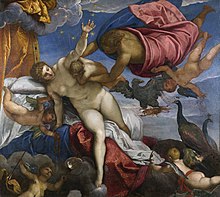
Astronomy has been a favorite and significant component of mythology and religion throughout history. Astronomy and cosmology are parts of the myths of many cultures and religion around the world. Astronomy and religion have long been closely intertwined, particularly during the early history of astronomy. Archaeological evidence of many ancient cultures demonstrates that celestial bodies were the subject of worship during the Stone and Bronze Ages. Amulets and stone walls in northern Europe depict arrangements of stars in constellations that match their historical positions, particularly circumpolar constellations. These date back as much as 30,000–40,000 years.
In many ancient religions, the northern circumpolar stars were associated with darkness, death and the underworld of the dead. For the Aztecs, the northern stars were associated with Tezcatlipoca. In Peking, China, was a shrine devoted to the North Star deity. Such worship of the northern stars may have been associated with time keeping, as the positions of the stars could identify the annual seasons. Likewise, as agriculture developed, the need to keep accurate time led to more careful tracking of the positions of the sun, moon and planets; resulting with their deification when they became inextricably linked with the means of survival. In the ancient Egyptian calendar, the date of the annual flooding of the Nile was predicted by observing the heliacal rising of a star. Indeed, the belief in a strong association between the events on the earth and in the heavens led to the development of astrology.
The first recorded conflict between religious orthodoxy and astronomy occurred with the Greek astronomer Anaxagoras. His beliefs that the heavenly bodies were the result of an evolutionary process and that the sun was a great burning stone (rather than the deity Helios), resulted in his arrest. He was charged with contravening the established religious beliefs. Although acquitted, he was forced to go into retirement.
As science expanded during the Renaissance, the secular beliefs of scientific investigators encountered the opposition of Christian orthodoxy. The most famous such conflict was that of Galileo Galilei, who was tried by the Inquisition on suspicion of heresy. However, many astronomers were also highly religious and attempted to reconcile their beliefs with the discoveries they made following the invention of the telescope.
Heliocentrism and Geocentrism
Heliocentrism is the idea that the sun is the center of the universe, and all the planets revolve around it. This is opposite to geocentrism in which the Earth is the center of the universe with the sun and all the other planets revolve around it. The geocentric model was the widely accepted model during the times of Plato, Aristotle, Ptolemy, and other astronomers. This model was rooted in observations made by astronomers at the time as well as being rooted in religion. Nicolaus Copernicus followed by astronomers such as Galileo Galilei and Johannes Kepler suggested a different model with the sun at the center of the universe. This model was also based on observation but incorporated the use of the newly created telescope as well as several mathematical observations creating orbits in the shape of ellipses. These models were not accepted by society which at the time was dominated by the Catholic religion and these astronomers received harsh criticism both the church and those around them.
The argument by Tammaso Cassini was that the bible did not support the Earth revolving around the Sun. One example provided was in Joshua 10 when God stopped the Sun for Joshua. It was also argued that God would place his greatest creation at the center of the universe thus moving the Earth out of the center took away from the greatness of his creation
Galileo and Religion
The Sidereus Nuncius written by Galileo in 1610, approved by the Holy Office, attracted much attention. This writing documented his observations using the telescope, describing the Moons of Jupiter and the mountains of the Moon.
By 1616 the Holy Office also known as the Inquisition condemned the Copernican theory henceforth condemning the works of Galileo. If the science did not back up scripture, then it was not to be taught.
By 1633, Galileo's new best-seller Dialogue Concerning the Two Chief World Systems had been prohibited. He recanted his heliocentrism and was sentenced to home arrest for the rest of his life. Four hundred years after Galileo's death, Pope John Paul II set up a committee to look into the trial and Galileo was pardoned.
